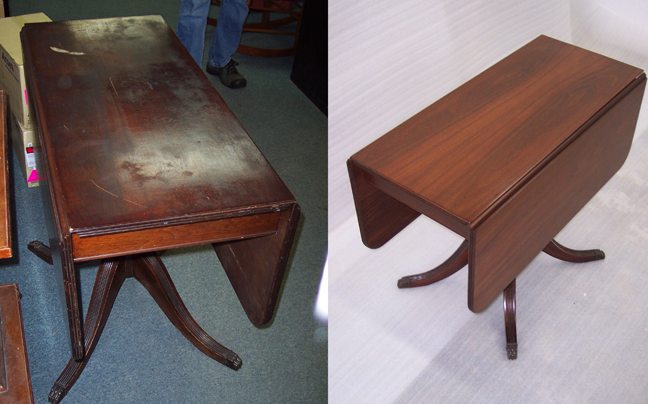Below are different types of finishes for wood furniture and their finishing techniques.

Wood Furniture Finishes
Surface Coatings
'Natural' Finishes
Pigmented Finishes
Penetrating Finish
Wax Polish
Wood Finishing Techniques
Staining
Glazing and Toning
Pickling and Liming
Bleaching
Distressing
Surface Coatings are clear, built-up, highly durable finishes that are virtually maintenance-free. Examples of surface coatings are varnish, shellac and lacquer. Surface coating finishes will add depth and warmth to the appearance of the woodwork, while enhancing the color and grain.
'Natural' Finishes are clear finishes that are used to add lustre, warmth, and character to the wood while protecting it from wear and tear.
Pigmented finishes are not transparent, and basically resembles paint. Black lacquer is a pigmented finish. We offer this finish in any color and sheen. We also offer two-toned finishes. An example of this would be a kitchen table with a 'natural' maple top and a forest green 'pigmented' base. Pigmented finishes can also be distressed and/or glazed.
Penetrating Finish, as the name suggests, penetrates the wood grain rather than 'setting up' on the surface and leaves no appreciable surface coating or film. This is done with oil. Oil will impart a beautiful low lustre finish, but requires more maintenance than the surface coating finish. Generally speaking, a penetrating finish is used when striving for a country or modern look.
Wax Polish is the ultimate rich-looking and labor intensive finish that seals and protects the wood. It is used to rejuvenate and old finish or can be used as a finish itself. Surprising to most, a professionally applied wax finish requires little maintenance. It can also be applied over a penetrating finish, to reduce the amount of maintenance that would typically be required.
Staining is used to enhance the true color of the woodwork or to achieve uniformity when the wood has an inconsistent appearance. It can also be used to change the natural color of the wood to a color more in keeping with the owner's tastes. We are masters at achieving a color specified by the customer. If we can't "hit the color" no one can.
Glazing and Toning are techniques used to highlight the details in the woodwork or to unify and add depth to the color. These two techniques can also be used to give "age" to the finish. The process is one of applying transparent pigmented liquid over or between coats of finish.
Pickling and Liming are traditional finishing processes used to accentuate the wood grain. The highlighting is achieved by using two contrasting colors: a base color and another color rubbed into the grain.
Bleaching is used to lighten the natural color of wood or to remove discoloration caused by moisture. Bleaching can also be used to achieve the base color in preparation for pickling or liming. It is not used to remove stain or dyes.
Distressing is a technique that can be used to give age and interest to the finish. This can be done any number of ways, including:
- sanding the finish away from areas that would have been worn over the years
- rubbing the finish away with a chemical
- striking the surface with a mix of objects that will randomly dent the finish
Now that you know the different wood finishes contact us and let us know which direction you would like to go with your next project.

